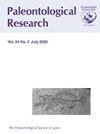Early Cretaceous Small-Sized Gastropods from the Shallow Marine Deposits of the Kimigahama Formation, Choshi Group, Japan
IF 0.6
4区 地球科学
Q3 PALEONTOLOGY
引用次数: 1
Abstract
Abstract. Twelve species of small gastropods are extracted using the sodium tetraphenylborate method from the strongly lithified shallow marine deposits of the Barremian (Lower Cretaceous) Kimigahama Formation of the Choshi Group, central Japan. They belong to the following families and subfamilies; Eudaroniidae, Pseudomelaniidae, Ampezzopleurinae, Metacerithiidae, Procerithiidae, Nystiellidae, Metaxiinae, Stuoraxidae and Ebalinae, including six new species and one new genus. Pseudomelania yamadai sp. nov., Ampezzopleura barremica sp. nov., Choshipleura striata gen. et sp. nov., Metacerithium boshuae sp. nov., Antiphora aurora sp. nov. and Stuoraxis kasei sp. nov. are described as new species. Pseudomelania yamadai, Metacerithium boshuae and Cirsocerithium subspinosum are closely related to or identical with the species from the Lower Cretaceous in western Europe. Ampezzopleura barremica and Choshipleura striata are the first Cretaceous records of the subfamily Ampezzopleurinae that has hitherto been limited to the Triassic deposits. Antiphora aurora is the first record of the family Triphoridae from Mesozoic deposits, suggesting that the sinistral triphorids originated from the dextral ancestor. Stuoraxis kasei is the youngest occurrence of the heterostrophan family Stuoraxidae that has hitherto been reported from the Permian to Middle Jurassic deposits. The sodium tetraphenylborate method for finding the small molluscs from the strongly lithified deposits is an effective tool with which to reveal the true diversity of the fossil molluscan fauna.早白垩世日本朝石组木冈滨组浅海沉积物中的小型腹足类
摘要使用四苯基硼酸钠法从日本中部Choshi群的Barremian(下白垩纪)Kimigahama组的强烈岩化浅海沉积物中提取了12种小型腹足类。它们属于以下科和亚科;Eudaronidae、Pseudomelanidae、Ampezzopleurinae、Metaceritidae、Procerithidae、Nystiellidae、Metaxiinae、Stuoraxidae和Ebalinae,包括6个新种和1个新属。山代假黑色素瘤(Pseudomelania yamadai sp.nov.)、巴氏Ampezzoplera barremica sp.nov..、条纹粗粒菌(Choshiplera striata gen.et sp.nov.%)、波氏Metacerithium boshuae sp.nov.mophora aurora sp.nov.Mantiphora kasei sp.nov.Stuoraxis kasei sp.nov.被描述为新种。亚马代假黑色素藻、波斯花Metacerithium boshuae和亚种Circocerithium subspinosum与西欧下白垩纪的物种密切相关或相同。斑胸蛙亚科和条纹胸蛙亚科是迄今为止仅限于三叠纪矿床的第一个白垩纪记录。Antiphora aurora是中生代沉积物中首次记录到三孔虫科,表明左旋三孔虫起源于右旋祖先。Stuoraxis kasei是迄今为止报道的二叠纪至侏罗纪中期沉积的异足目Stuoraxidae中最年轻的一种。四苯基硼酸钠法从强锂化沉积物中寻找小型软体动物是揭示软体动物化石真正多样性的有效工具。
本文章由计算机程序翻译,如有差异,请以英文原文为准。
求助全文
约1分钟内获得全文
求助全文
来源期刊

Paleontological Research
PALEONTOLOGY-
CiteScore
1.60
自引率
0.00%
发文量
47
审稿时长
>12 weeks
期刊介绍:
Paleonotological Research (PR) is a quarterly, peer-reviewed international journal, which focuses on original contributions primarily in the area of paleontology but also covering a wide range of allied sciences. It has been published since 1997 as a successor to the former journal Transactions and Proceedings of the Palaeontological Society of Japan. The emphasis of contributions will include global and local perspectives, and contents can cover all ages (Precambrian to the Quaternary, including the present time).
 求助内容:
求助内容: 应助结果提醒方式:
应助结果提醒方式:


